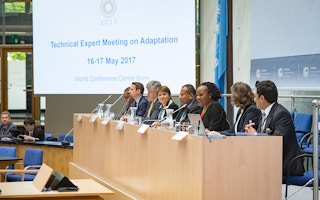Climate negotiations are a highly complex undertaking with one simplifying factor that everything happens in one place. But for the current round of negotiations in Bonn, Germany, even this isn’t the case.
While diplomats have come together from around the world try to hash out a “rule book” for operationalising the Paris Agreement, the potential success of the agreement has been called into question by the Trump administration.
The first clue that circumstances had changed was the number of delegates the US sent to Bonn. At just seven people, this was less than half that of Vietnam, whereas Germany registered some 50 people.
During the opening statements, several countries requested the US not turn its back on the Paris Agreement. The potential US withdrawal was also the focus of press conference questions and hallway chitchat.
The Chinese delegation, especially, is said to have put pressure on the US, pointing out that a withdrawal from Paris would have severe consequences for bilateral relations.
Meanwhile, at the UN energy forum in Vienna, India’s energy minister Piyush Goyal, reaffirmed his country’s engagement with Paris “irrespective of what happens in the rest of the world”.
“
We really have to see what it is the Trump administration will come forward with because it is important to keep in mind that parties can deliver on their pledges in different ways.
Yvon Slingenberg, spokesperson, EU Commission
His speech has been widely praised. “This is proof of India’s decisive leadership on climate change as they embrace the clean energy revolution to power their homes and create jobs,” said Paula Caballero, from the World Resources Institute.
To stay or go
On May 9 the US government announced it would postpone a decision on the Paris Agreement until after the G7 summit in late May. Optimists considered this a good sign as it gives other G7 leaders the opportunity to personally lobby President Trump. Furthermore, Trump will meet the Pope on May 24, who has also come out strongly in favour of climate action.
But even if the US stays in the Paris Agreement, it is still expected to weaken its domestic emission targets.
Whether such action is permitted by the Agreement is still unclear. Much discussion has revolved around the meaning of article 4.11, which states that a country “may at any time adjust its existing nationally determined contribution with a view to enhancing its level of ambition”.
While the Moroccan foreign minister Salaheddine Mezouar said that commitments were “irreversible,” the EU Commission spokesperson, Yvon Slingenberg,was more circumspect:
“We really have to see what it is the Trump administration will come forward with because it is important to keep in mind that parties can deliver on their pledges in different ways,” she said.
Meanwhile, for Laurence Tubiana, one of the architects of the Paris Agreement, the question is clear as she wrote in a tweet: “Of course US government CAN legally downsize its contribution but SHOULD Not.”
On the other hand Jonathan Church, a lawyer for the legal NGO ClientEarth, argued in Carbon Brief that this is an “unduly permissive interpretation of Article 4(11),” and weakening the targets would be a “breach of the Paris Agreement.”
A distraction
Bonn marks the halfway point between the climate conference in Paris and the conference next year where a “rule book” will be adopted.
The Paris Agreement needs such an operating manual because many details have not been decided. For instance, Article 13.13 requires countries to “adopt common modalities, procedures and guidelines (…) for the transparency of action and support”. But the question of what countries report, when and how still remains unanswered.
The goal of the current session is to establish the outline of a draft negotiating text.
Time and again the distinction between developed and developing countries – formally abolished in the Paris Agreement – has resurfaced. For example, shall there be one set of “modalities, procedures and guidelines” or shall there be two sets: one for developed countries and one for developing ones?
But the most consequential issue in Bonn has been the form of the “ratchet mechanism”. The climate plans that countries have submitted (known as Nationally Determined Contributions or NDCs) would push global warming to 2.6-3.7C above pre-industrial levels, meaning countries will fall short of the goal of limiting warming to “well below 2C” and “to pursue efforts to limit the temperature increase to 1.5C”.
Countries are supposed to ratchet up their commitments and to submit increasingly ambitious NDCs. The ratchet process will be based on “global stocktakes” every five years at which countries will determine whether they are on track. But how the stocktakes will work is currently under negotiation.
The first informal one, known as the “Facilitative Dialogue”, will take place in 2018 parallel to the adoption of the rule book and the publication of the IPCC special report on the 1.5C goal.
Another issue is the UNFCCC budget for the years 2018 and 2019. The UNFCCC Secretariat has requested almost 59 million euros (US$65 million) for the two years – an increase of 9.7 per cent. However the UNFCCC has been roundly criticised for proposing to eliminate its contribution to the Intergovernmental Panel on Climate Change (IPCC).
However, the UNFCCC may have no choice in the matter as one of the declared aims of the Trump administration is to stop US government support for climate finance. Currently the US covers around a fifth of the UNFCCC budget.
To save this membership fee though, the US would have to withdraw not only from the Paris Agreement but also from the UNFCCC. Thankfully, this is not under discussion quite yet.
This story was originally published by Chinadialogue under a Creative Commons’ License and was republished with permission.










